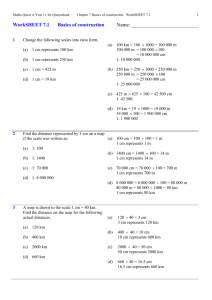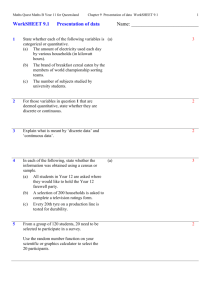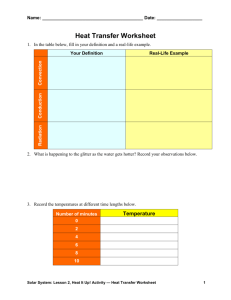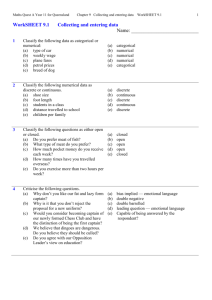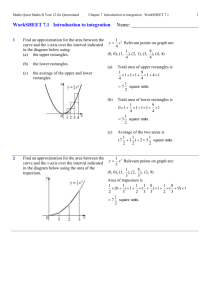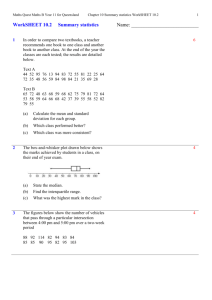Worksheet 7.2
advertisement
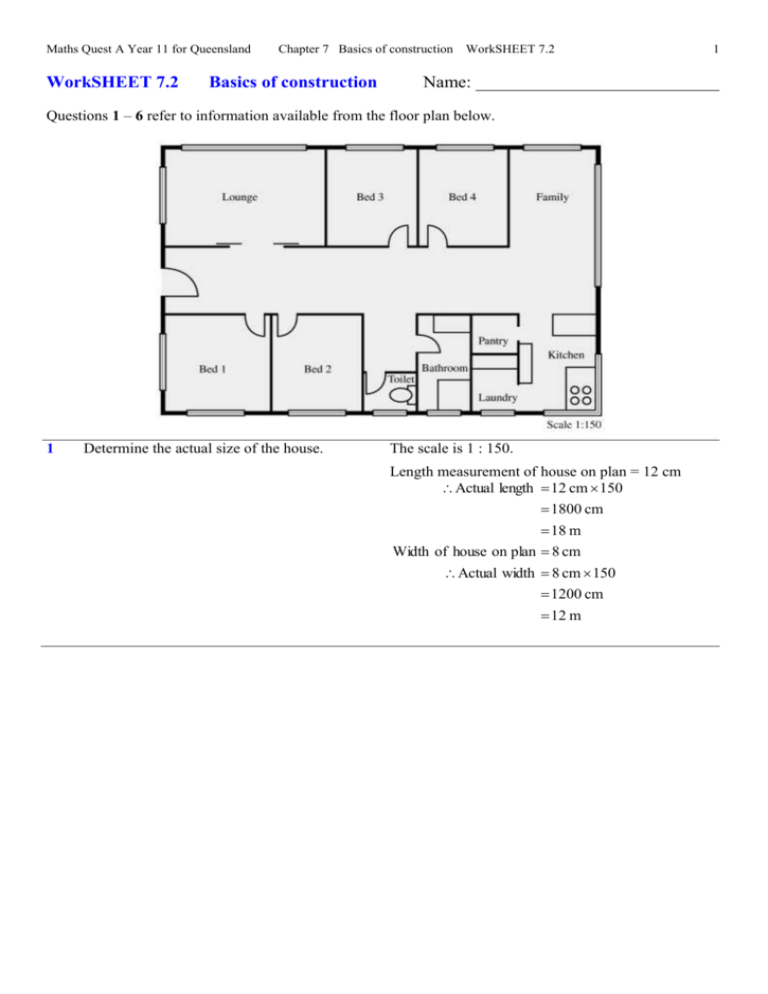
Maths Quest A Year 11 for Queensland WorkSHEET 7.2 Chapter 7 Basics of construction Basics of construction WorkSHEET 7.2 Name: ___________________________ Questions 1 – 6 refer to information available from the floor plan below. 1 Determine the actual size of the house. 1 The scale is 1 : 150. Length measurement of house on plan = 12 cm Actual length 12 cm 150 1800 cm 18 m Width of house on plan 8 cm Actual width 8 cm 150 1200 cm 12 m Maths Quest A Year 11 for Queensland 2 Chapter 7 Basics of construction WorkSHEET 7.2 If the house was pegged out correctly so that it was rectangular in shape with the corner angles being right angles, what would its diagonal length be? Using Pythagoras’ Theorem. hypot. 2 base 2 ht 2 diagonal 2 18 2 12 2 324 144 468 So, diagnonal 468 21.6 m Diagonal length 21.6 m 2 Maths Quest A Year 11 for Queensland 3 Chapter 7 Basics of construction WorkSHEET 7.2 If 6 m lengths of trench mesh were laid in the footings around the perimeter of the house, how many lengths would be required for two layers of mesh? The mesh must overlap at the corners and where two sheets meet, the overlap must be 500 mm. Note that the mesh lengths can be cut if necessary. Remember to allow for 500 mm overlap. The length of the plan would require 3 lengths (17 m) + 1.5 m. So, both lengths would require 6 lengths + 3 metres i.e. 6 12 lengths The width of the plan would require 2 lengths (11.5 m) + 1 metre So, both widths would require 4 lengths + 2 metres Total required = (6 lengths + 3 m) + (4 lengths + 2 m) = 10 lengths + 5 m So, number of lengths required for 1 layer = 11 Two layers would require 11 2 = 22 lengths 3 Maths Quest A Year 11 for Queensland 4 Chapter 7 Basics of construction WorkSHEET 7.2 What would be the cost of concrete for the footing around the perimeter of the house, if they are 350 mm wide and 200 mm deep, and concrete costs $130/m3? Outer area of floor = 18 m 12 m = 216 m2 Inner area of floor = (18 – 2 0.35) m (12 – 2 0.35) m = 17.3 m 11.3 m = 195.49 m2 Surface area of footings = outer area – inner area = 216 m2 – 195.49 m2 = 20.51 m2 Volume of footings = surface area depth = 20.51 m2 0.2 m = 4.102 m3 Cost of concrete = 4.102 m3 $130/m3 = $533.26 5 Determine the cost of concrete for the slab of the house (100 mm thick) at $130/m3. Volume of concrete = L W H = 18 m 12 m 0.1 m = 21.6 m3 Cost of concrete = 21.6 m3 $130/m3 = $2808 4 Maths Quest A Year 11 for Queensland 6 Chapter 7 Basics of construction WorkSHEET 7.2 The wall separating the lounge from bedroom 3 requires bracing. The height of the wall is 2.4 m and its length is 4.2 m. Would it be acceptable to put a brace diagonally across the wall from a floor corner to a ceiling corner? Explain your answer. For a brace to be acceptable, it must lie within an angle range of 37º to 53º with the horizontal. tan 2 .4 4 .2 2 .4 4 .2 tan 1 29.7 This brace is not acceptable as it lies outside the range 37º to 53º. Questions 7 – 10 refer to information available from the front elevation shown below. 5 Maths Quest A Year 11 for Queensland 7 Chapter 7 Basics of construction WorkSHEET 7.2 The main section of the roof is in the shape of a gable roof with a pitch angle of 28º. Express this as a pitch ratio. Pitch ratio is the tangent ratio in the form 1 : x. 1 tan 28 x x tan 28 1 1 x tan 28 1 .9 So, pitch ratio is 1 : 1.9. 8 Use the scale indicated on the plan to determine Front length measures 10.8 cm. the length of the front of the house. Scale is 1 : 100. Length of front of house 10.8 cm 100 10.8 m 9 If the side of the house (from front to rear) is 8 m, determine the area of the roof. (Assume that the roof does not overhang the walls in any direction.) The roof consists of 2 rectangles x metres by 10.8 metres adj. hypot. 4 x cos 28 x cos 28 4 x 4 cos 28 4.5 m Area of roof 10.8 m 4.5 m 2 m 97.2 m 2 6 Maths Quest A Year 11 for Queensland 10 Chapter 7 Basics of construction The brick wall beneath the front of the house approximates the shape of a triangle. Use the scale of the plan, together with the estimated requirement of 50 bricks per square metre, to determine the number of bricks required for this wall. WorkSHEET 7.2 7 Measure length ' h' on plan 9.1 cm So, actual length of ' h' 9.1 cm 100 9.1 m Measured length ' b' on plan 1.3 cm So, actual length of ' b' 1.3 cm 100 1.3 m b h 2 1.3 9.1 2 Area of bricked region 5.915 m 2 Brick requiremen t 50/m 2 Number of bricks required for this region 5.915 50 295.75 approximat ely 300
